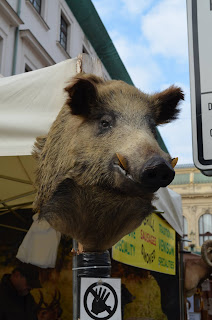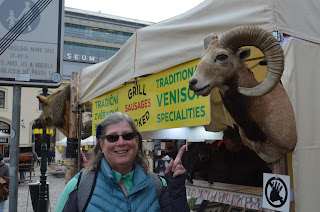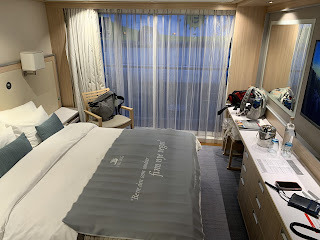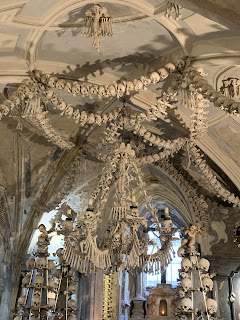Thursday, October 31, 2019; Passau, Germany
Our ship remained docked in the commercial slipway overnight. We had felt the ship rocking for a while after we had gone to bed, but that was due to a changing of the ship that had been rafted alongside. When we awoke, we could see the tour buses waiting alongside the ship. If we had been one floor down, our view would have been of the wall of the slipway, or if we were on the opposite side of the ship, it would have been directly into the adjacent ship’s veranda.
We had breakfast in the dining room. The breakfast was set up with a buffet featuring an omelette and egg station. They had plums wrapped in bacon as a regional item.
After breakfast we walked a little around the bus boarding area. Ben found an unusual looking plant growing nearby. Google Photos identified it as a Thorn Apple, which in addition to being an odd looking plant, is chock full of pharmaceuticals and highly poisonous.
Thorn Apple
Every part of the plant is considered poisonous- stems, leaves, seeds, and roots. It contains alkaloids and opioids. Apparently, some herbalists throughout the ages have used it to treat schizophrenia, GI troubles, or simply for it’s hallucinogenic and psychotropic effects, but the therapeutic margin (difference between a useful and a deadly dose) is extremely thin.
Because our boat was parked a couple miles upstream from the historic district of Passau, we boarded buses and were driven to the historic district, where other river cruise ships were tied up. We then broke up into smaller groups. Our guide, Andrea, was a Passau native, and she was very enthusiastic and had a great sense of humor. We did a walking tour of the old town noting flood markers on some of the buildings. The highest flood in history occurred in 2013.
We had stopped in Passau during our 2015 Viking river cruise from Budapest to Nuremberg, so we didn’t really see anything new on this tour, but did attend a formal organ concert in the Passau Cathedral. The pipe organ actually consists of 5 organs that can all be played from a central keyboard. There are just under 18,000 pipes in the complex, making it the largest cathedral organ in the world.
Salt silo on the Inn river, Passau, Germany
Literal Pigeon hole in the Salt Silo
St Paul Church, Passau, Germany
St. Stephens Cathedral, Passau, Germany
St Stephens Cathedral organ in Passau, Germany.
Largest church organ in Europe with nearly 18,000 pipes. Probably
the second largest church organ in the world- actually a composite
of five organs linked by a central console.
St Stephens Cathedral Passau, Germany
St Stephens Cathedral, Passau, Germany. Not expecting to see these in a church.
St Stephens Cathedral, Passau, Germany. There’s that flaming sword!
We didn’t have much free time after the concert to wander the city, so it was a good thing we had done so in 2015.
The ship headed downstream to the confluence of the three rivers (Danube, Inn and Ilz) in reverse, doing a “Y” turn up the Inn so it could then proceed bow first further downstream.
The ship went through a lock about 2 hours out of Passau which dropped us about 25’. The upstream gates were vertical shutters, while the downstream gates swung out from the sides. We did pass a few RV and trailer home parks along the banks of the Danube as we made our way downstream. It wasn’t long before we saw Austrian flags on either side of the river.
Confluence of the Danube, Inn and Ilz rivers at Passau, Germany
The ship went through a lock about 2 hours out of Passau which dropped us about 25’. The upstream gates were vertical shutters, while the downstream gates swung out from the sides. We did pass a few RV and trailer home parks along the banks of the Danube as we made our way downstream. It wasn’t long before we saw Austrian flags on either side of the river.
In the afternoon, there was a Strudel making demonstration. Ben was able to volunteer, along with another young woman, to assist the chef in preparing a Strudel. Instead of stretching the dough, as we had seen in the demonstration in 2015, we rolled out the dough.
The Strudels we prepared disappeared below decks at the conclusion of the demonstration, with the dining room staff serving professionally made strudel to the passengers in time for afternoon tea. Ben got to keep a souvenir Viking Cooking School apron, which was a nice touch. As we sampled the strudel, we met an older couple from western Illinois who had been in Prague when it was under communist rule for a semester, teaching college. They corroborated stories told to us by our Prague guides about how there was nothing you could buy with what money you had.
Guest Strudel Chef
The regional specialty dinner menu featured a collection of dumplings, which was interesting, but not particularly memorable. We would prefer Xiao Long Bao Chinese soup dumplings, but when in Austria...
As we ate dinner, the ship passed another lock in the dark and eventually ended up tied up between two boats in Linz. The view out our balcony is another ship’s French balcony with its curtains drawn. With a view like that, you might just as well book an inside cabin, but that will change after we enter the Wachau valley.
The evening entertainment was a group of singers from Salzburg who did a selection of opera and soundtrack songs from the Sound of Music. The group arrived a half hour late because they got caught up in traffic, and when they started, the room lighting was dim, and you could not see them in the front of the room. They also didn’t have microphones, so if you weren’t in the front of the lounge, you wouldn’t have been able to hear them. We asked one of the Viking staff to turn up the lights and give them some microphones, which they obliged after the first 3 songs. That improved the experience, although their singing was of only meager professional level- probably good enough for entry level cruise line performers, but below Branson Missouri or better cruise line level. We were pretty tired and struggled to stay awake through it. It made us miss the quality of entertainment that we are used to on Princess cruises.
Tomorrow, we will be taking an included excursion that will bus us 90 minutes back into the Czech Republic to tour a UNESCO world heritage village of Cesky Krumlov. For those on the ship who didn’t pre-cruise in Prague, this will be an opportunity to add another country to their travel credentials. The alternative of staying in Linz for a much shorter walking tour is significantly downgraded by the fact that it will be All Saints Day in Austria, and all shops and offices will be closed for a national holiday. The Czechs do not treat All Saints Day as a national holiday, so it will be business as usual. The distance from the cruise ship port means we will spend 3 hours commuting over the course of the day, but the cruise director assures us that the village is a gem worth seeing.




















































